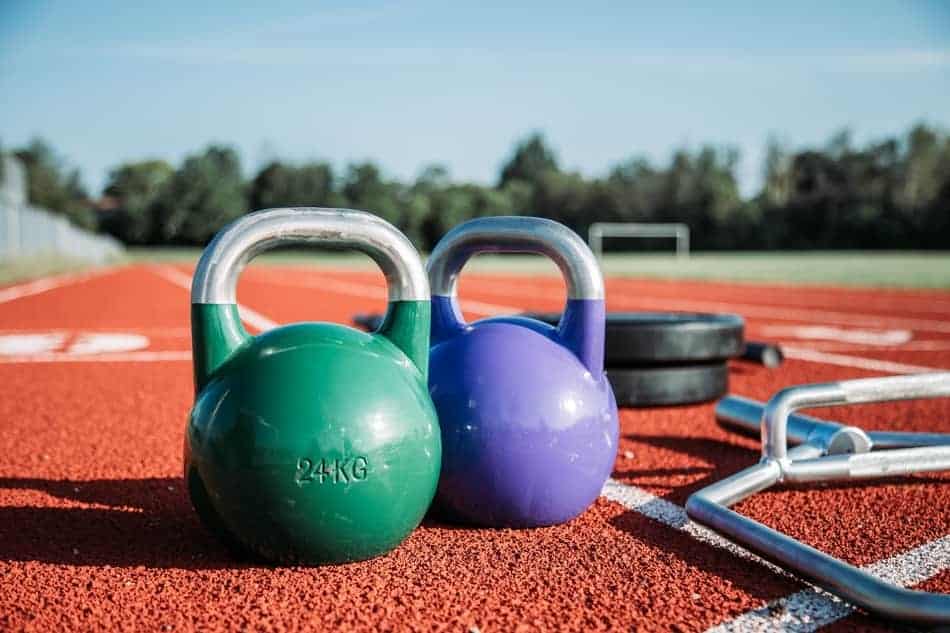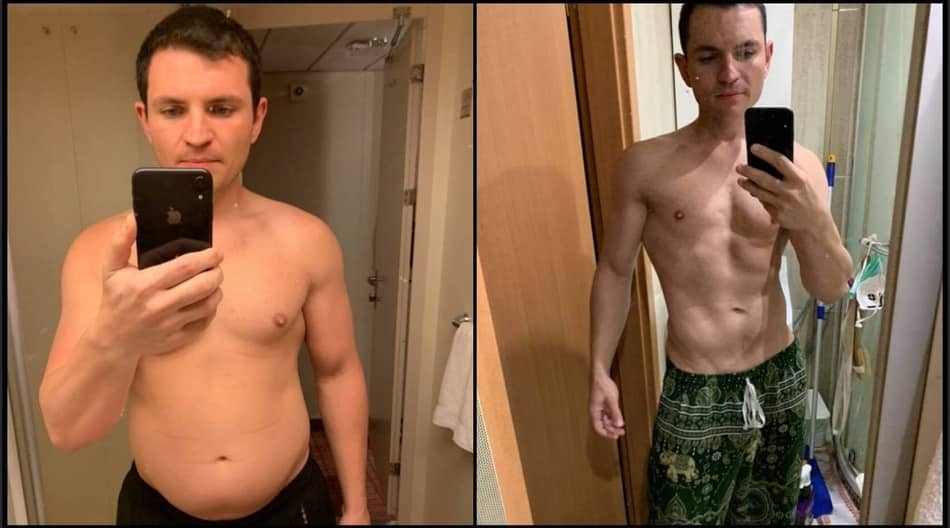In 2020 (when gyms were shut down) I was forced to do workouts at home. Instead of getting a bunch of equipment, I decided to go minimalistic and get one kettlebell (I was doing mostly kettlebell swings).
As you may guess, today I will explain if doing kettlebell swings is enough to get you in shape.

As a whole, you can do only kettlebell swings for your workout at least for the short term. It’s ok to minimize your workout routine to a single exercise, and it is imperative that you choose an exercise that can work on multiple muscle groups.
Plus, kettlebell swings work on several muscle groups, and they make you stronger at everything else that you do (more on that later).
Can I Only Do Kettlebell Swings?
In general, it is possible to train by only doing kettlebell swings. Minimizing your training routine to just one or two exercises in a short time can help to balance your strength, focus on your weak points and simplify your workout routine.
Simple and minimalistic means less hassle, yet it’s still challenging (the challenge is a good word to think about it).
Why I started doing only kettlebell swings
A few years back one of my buddies Sergiu introduced me to a new way of looking at my workout (that was before the lockdown).
To keep it simple and minimalistic.
So I did pull-ups (and I was blown away with my results).
- My forearms were jacked and my back was ripped.
- I was able to do 15-18 pull-ups in one set with just my body weight alone.
- On the days when I used a weighted vest, I was doing sets of 7-12 reps.
(if you buy through links on this page, I may earn a small commission).
However, since the gyms were under lockdown, I needed to continue with my workouts at home. So my new challenge was kettlebell swing.
Doing less is more
Ludwig Mies van der Rohe
Doing kettlebell swings alone can get you jacked
I know it’s a bold claim. How is it possible that one exercise can get you stronger at everything else? It sounds like some bro-science.
That’s exactly what I thought.
But having the experience of my pull-up challenge made me believe that I can see huge results just from the kettlebell swings too.
After 20 years of doing marathon running, Olympic lifting, yoga, kickboxing, cycling, you name it, I thought I knew it all. I was wrong. I guess we never stop learning.
The kettlebell swings workout changed my life.
Normally, before I do any changes to my routine I like to satisfy my curiosity with a lot of data.
That’s when I spend hours reading studies from scientific journals about the current research in the field. Kettlebell swings were no exception. Let me show you what I mean.
Kettlebell swings only workout
You can do kettlebell swings as a part of your strength training program.
- They have been proven to develop strength, power, conditioning, and body composition.
- Kettlebell swings can be used in the combination with other exercises, or simply by themselves.
Case study 1
In one study, Jason P. Lake, Ph.D., from the University of Chichester in the United Kingdom compared a group of healthy men.
Here are the details.
- Duration – 6-weeks
- Frequency – twice a week
- Intensity – 12 rounds of 30-second kettlebell swings
- Rest – 30-second between sets.
The goal of the study was to assess if kettlebell swings can increase the maximum strength in a 1RM squat, and explosive strength in the vertical jump.
So basically they wanted to know if just by doing a kettlebell swing they could squat more and jump higher.
Here’s what happened.
The group was measured before and after the 6-week program.
- The results of this study demonstrated that after the 6-week time, the group had increased their explosive strength by 19.8% and the maximum strength by 9.8%.
Interesting (remember that this was done with just the two weekly 12-minute sessions).
Case study 2
Kettlebell swings are not a magic pill. This means that they can make you stronger, but not from every single angle.
Let me explain.
In another study, Marek Kruszewski, Ph.D., from the University of Physical Education in Warsaw, Poland, investigated how effective kettlebell training would be on a group of football players.
- The typical football training consists of 40-yard runs, shuttle runs, jumps, power, and strength exercises.
- This was a long-term (eight months) research.
- One group was doing strictly kettlebell workouts.
- Another group was doing regular American football system training. All participants were measured before and after the eight-month cycle.
There were 5 tests.
| 40-yard run |
| Running through the arch (agility test) |
| Countermovement jump |
| Long jump power test |
| 100kg bench press |
- After 8-months of time, both groups had similar results with 4 out of 5 tests (run, agility, jump, and power).
However, when it comes to the 100kg bench press, the kettlebell group had significantly worst results.
That’s why I love science. You can see in black and white what is working, and what is not.
What about recovery?
You can use kettlebell swings as your recovery exercise, or even as a rehabilitation tool.
- Thanks to its high-velocity low load, it can positively impact your posterior chain muscle groups.
- It creates compression in the lower back area which is known for its recovery benefits.
The main objective of a rehab therapist is to bring the injured athlete back to normal as quickly, and as safely as possible.
Although PTs have many options for exercises to choose from, kettlebells seem to gain more and more popularity, especially in the chronic phase of rehab.
One key benefit of doing kettlebell swings is that they specifically target the medial and lateral hamstring muscles (biceps femoris and semitendinosus), two of the muscles that help to avoid knee injuries.
So during the PT of a knee injury, those two muscles are usually part of a strengthening program (source).
Here is another example.
- A 21-year-old female athlete, a soccer player, was at high risk of injury after having her ACL reconstruction and was following a 6-week kettlebell swing protocol.
- Long story short, after a 6-week period, she changed her high-risk profile to low-risk (source).
It’s pretty remarkable that by doing the kettlebell swings only, she could actually strengthen not just the muscles, but the ligaments too.
So, in my opinion, if something is good enough for a high-level athlete, then it must be good for regular people too.
My experience of doing only kettlebell swings
The initial concerns I had before I started doing kettlebell swings-only workouts were about volume and rest.
I think that just because doing something is good for you, it doesn’t mean that more will be better.
It is easy to get excited from seeing all that data and jump all into the training and forget that our body actually needs to heal itself.
Below you can see my results (before and after picture) from doing kettlebell swings only workout.

Another really important aspect is the weight of the kettlebell.
Some studies suggest that there may be the same physiological responses to kettlebell swings, regardless of the weight you are using.
However, the perceptual response is greater with a higher weight (it means you just feel like you had a good workout when you increase the weight).
I choose a 24kg kettlebell (50lbs) as my weight. I could start with a lighter weight. But I was already familiar with 50lbs weight dumbbells before.
My kettlebell swings-only workout plan
Before I started my workout, I did a small assessment to measure my strength progress.
Here you can see the reps and sets of some exercises that I was able to do before my kettlebell swings-only workout using a 50lbs dumbbell.
| Goblet squat | 20+ reps |
| Single Arm Row | 12-15 reps |
| Shoulder press | 5 reps |
I used that as my benchmark.
If I was able to do those exercises with that many reps, then I felt confident I could go ahead with a 24kg kettlebell.
1-2 weeks
100 reps
| Kettlebell Swing | 10-15 reps | 7-8 sets |
- I was patient.
- I didn’t care to see progress as fast as possible. I knew it will be a long game.
- I started by doing 100 reps of kettlebell swings every day, for 2-weeks. That was enough to see how my body will feel and respond.
3-5 week
150 reps
| Kettlebell Swing | 15-20 reps | 7-9 sets |
- Then on week three, I rump up to an average of 150 reps. Keep in mind that some days I would do 180, even 200 reps.
- On the other days, I was closer to 100. So the average volume would be 1000 reps per week.
6+ week
200 reps
| Kettlebell Swing | 25-30 reps | 6-8 sets |
- After week six I went to an average of 200 reps per day. That time I also added some push-ups here and there.
- Also, remember that I had the advantage of doing the training at home.
Tips
Take a long rest in between
- I could spend even up to 5 min resting in between.
- Usually, I would be doing something else at that time (cooking, blogging, calling friends, cleaning).
The entire program took me 4 months.
Watch your protein intake
My diet was moderate. I wasn’t focused on macronutrients.
My goal was to create a minimalistic workout that can be part of my everyday routine. I wanted to be more productive during the day and I needed a tool to give me more energy, not a performance so to speak.
Final thoughts
I believe that kettlebell swings-only training is a perfect solution for everyone who is looking for training that is simple and effective at the same time.
Conclusion
- Kettlebell swings can be part of your regular workout.
- You can do them for years. But as a single exercise, think about it as a challenge, not as a lifetime practice.
- I recommend 3-6 months. That really worked on the weak spots that I was neglecting in the past.
- You can do kettlebell swings every day, as long as you stay in a low volume (reps and sets) range.
- Do just a few sets per day and as you notice you’re getting stronger, increase the volume.
